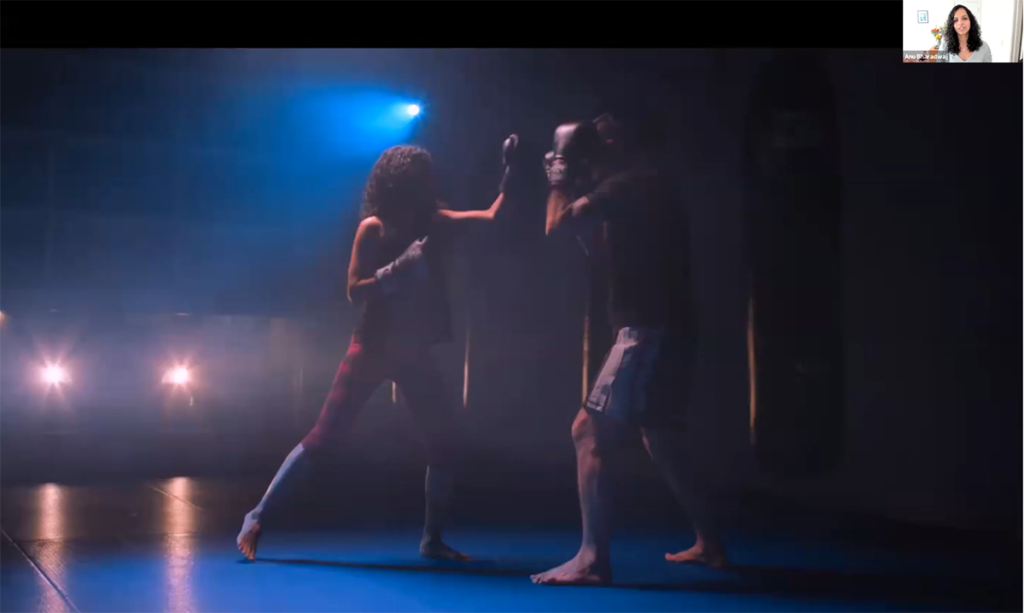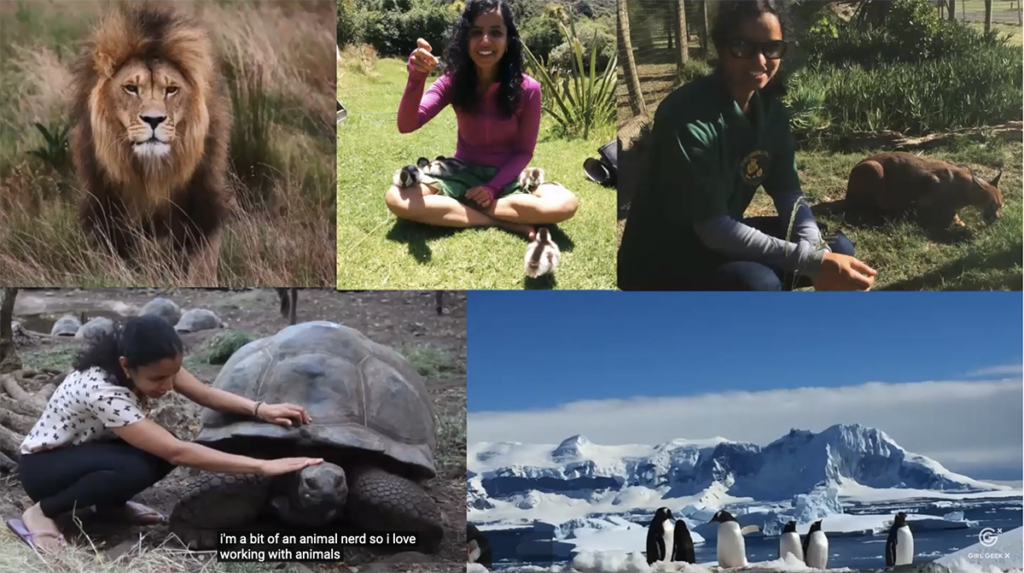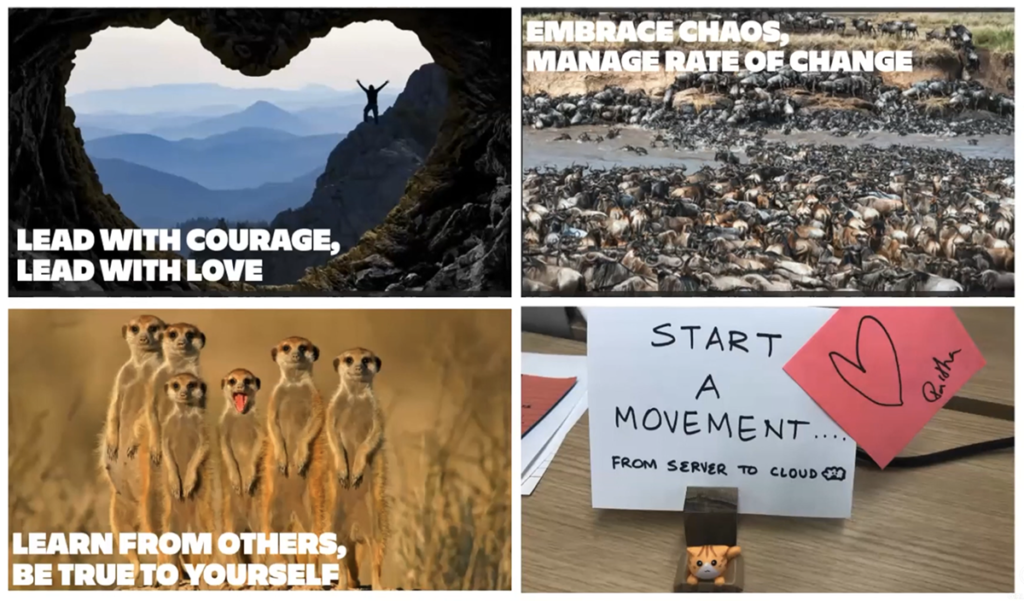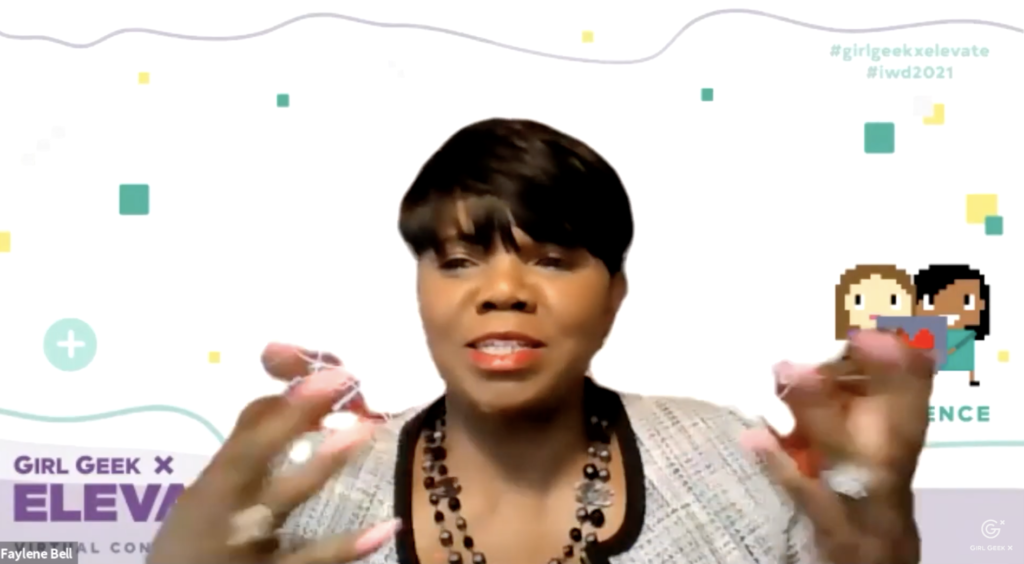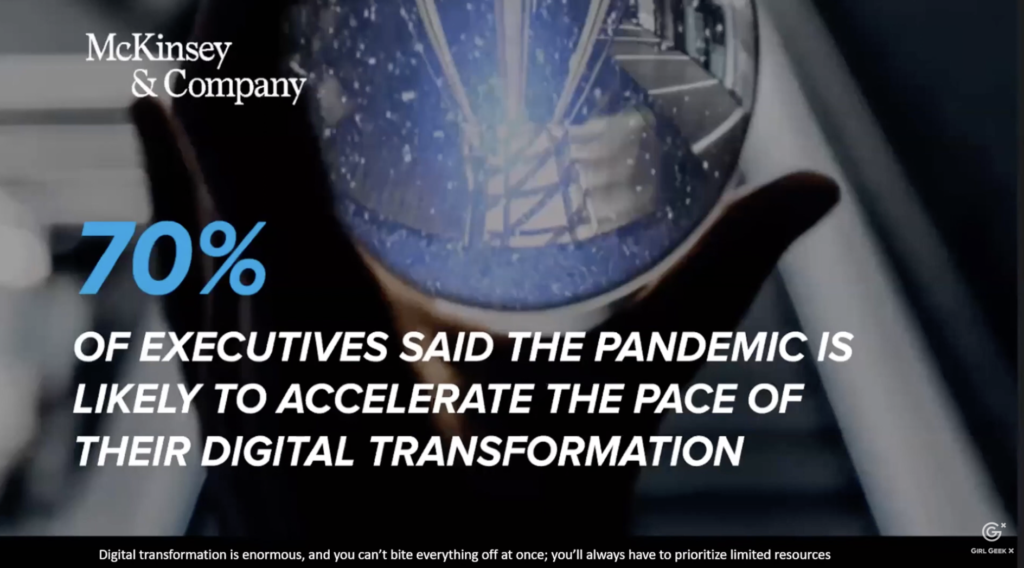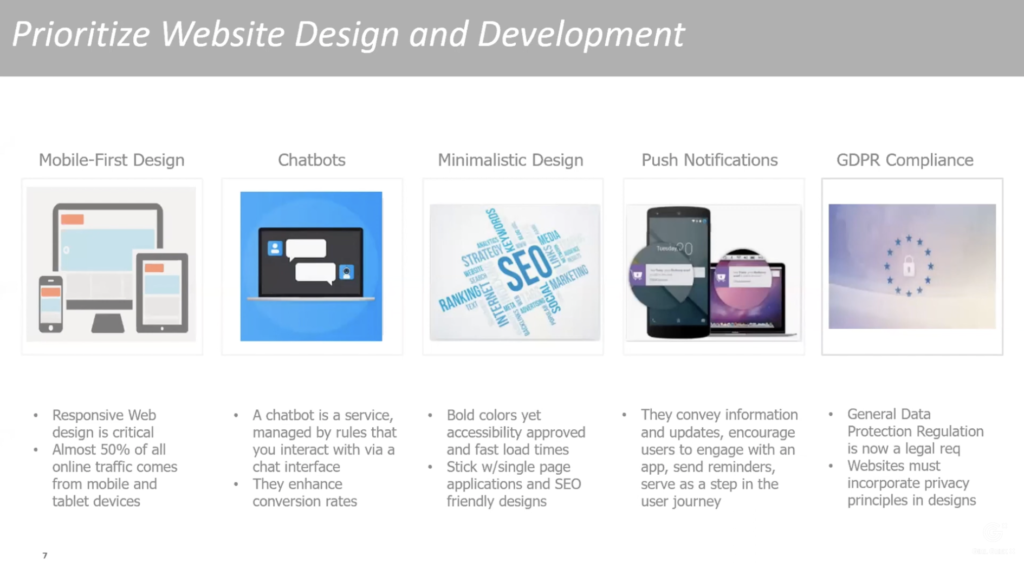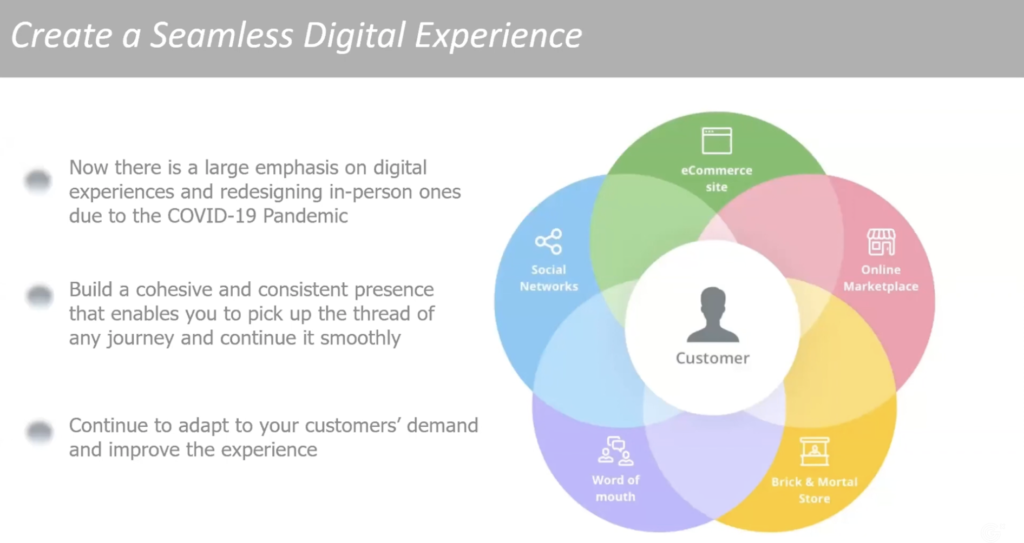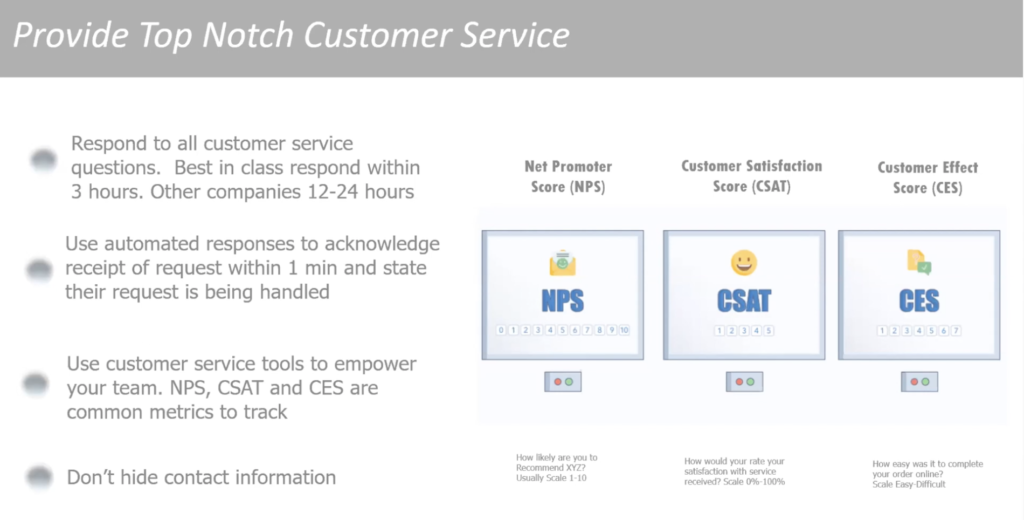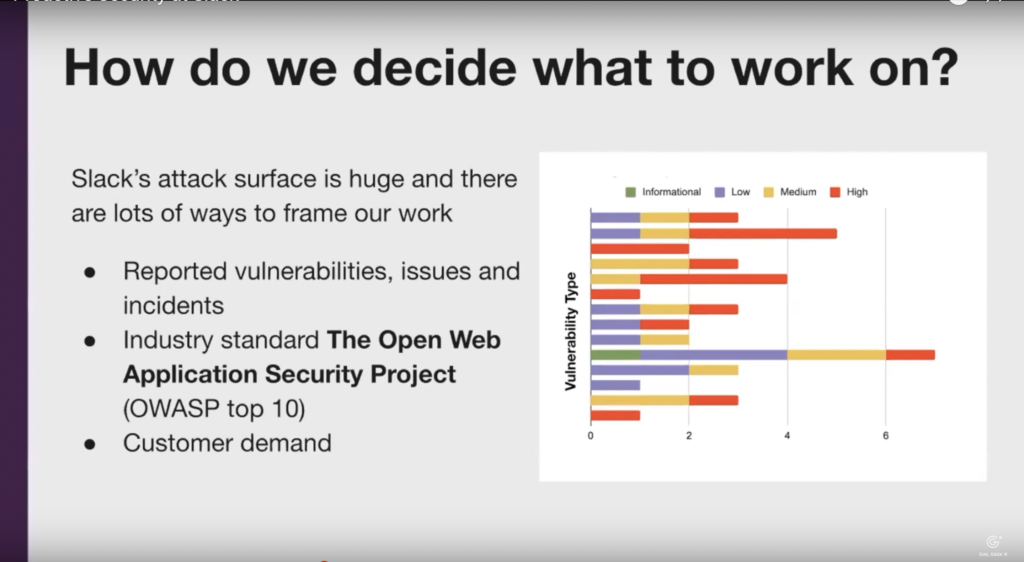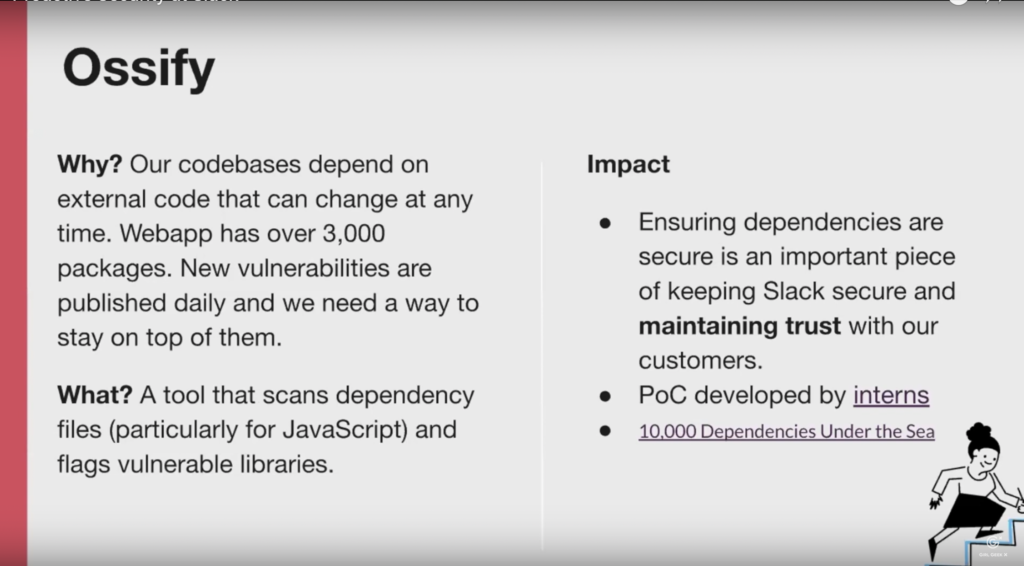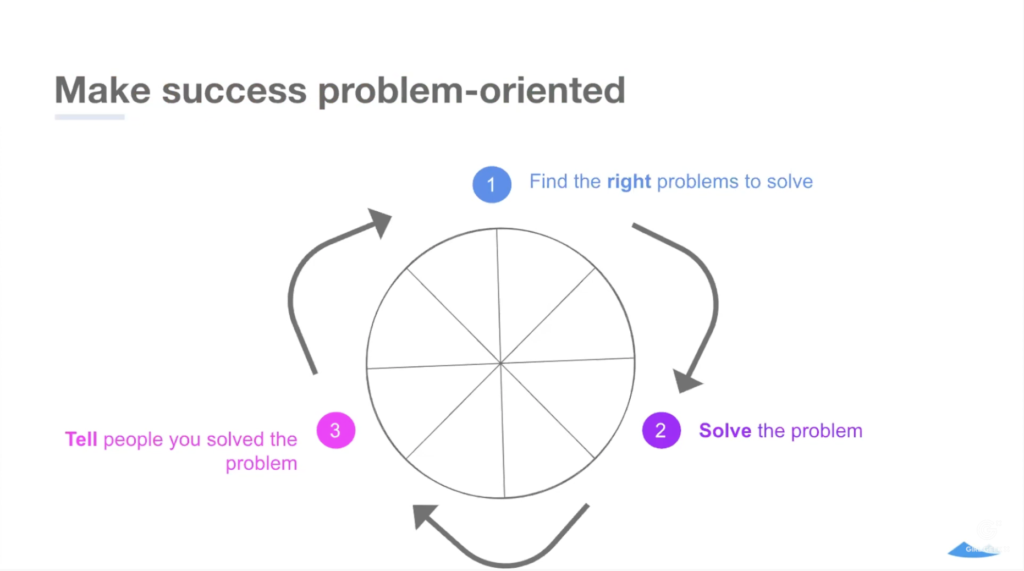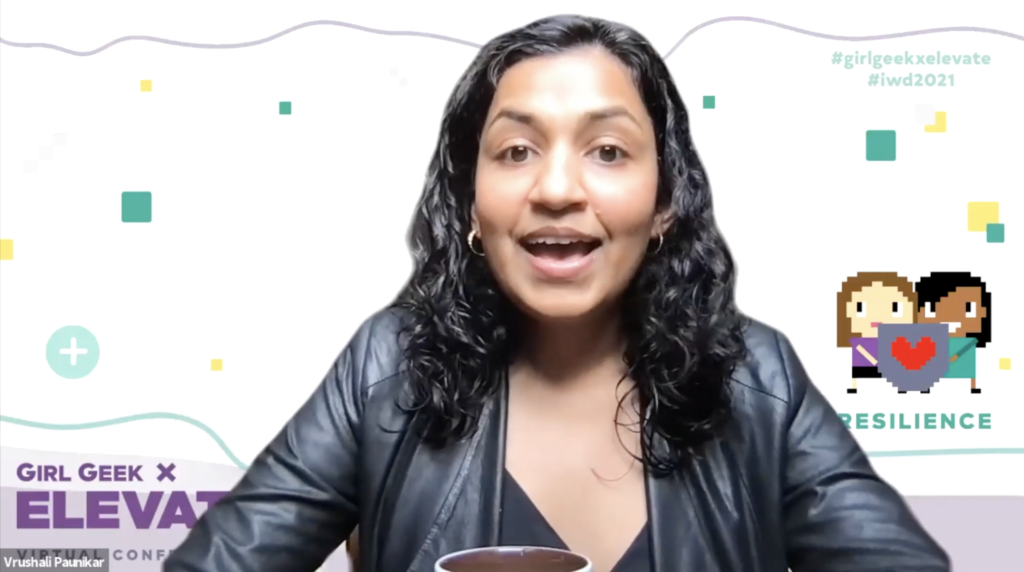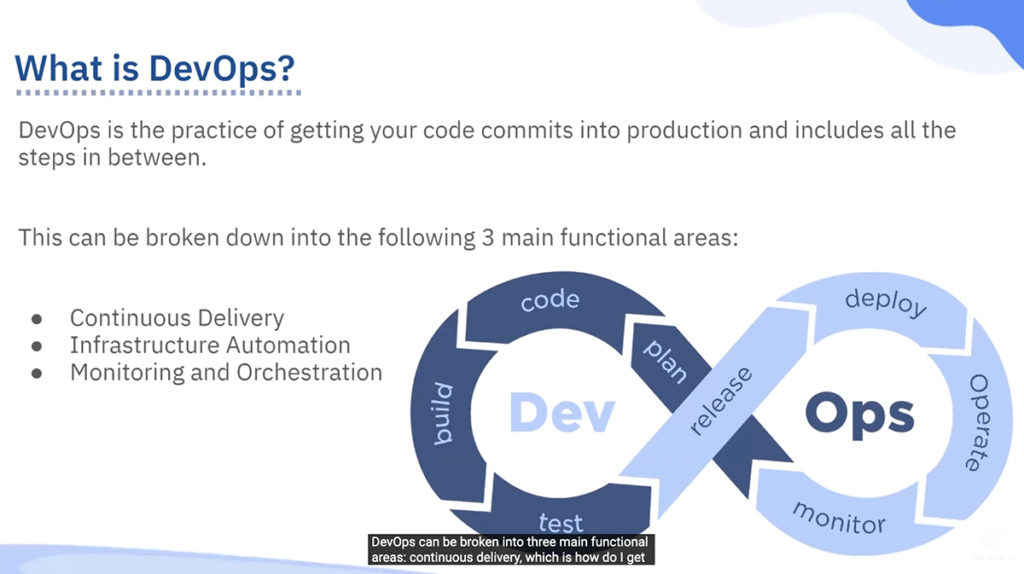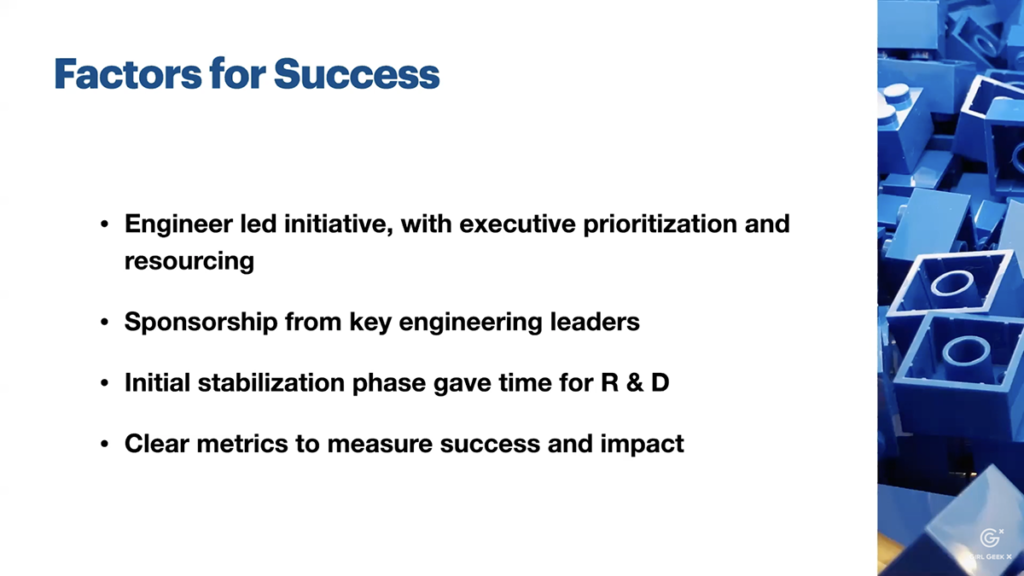Like what you see here? Our mission-aligned Girl Geek X partners are hiring!
- See open jobs at Salesforce and check out open jobs at our trusted partner companies.
- Watch all Elevate 2021 conference video replays!
- Does your company want to sponsor a Girl Geek Dinner? Talk to us!
Transcript
Sukrutha Bhadouria: And we will move on to our afternoon keynote, which I’m super excited about.
Sukrutha Bhadouria: Our afternoon keynote is with none other than Ashley Dudgeon. Ashley Dudgeon is VP of Software Engineering at Salesforce, where she has worked for over a decade. She began her career as a software developer after graduating from UC Berkeley with a degree in computer science. She believes cultivating engaged, innovative, and transparent organizations is a prerequisite to building amazing software, and I have had a courtside view of that. Welcome, Ashley.
Ashley Dudgeon: Thank you, Sukrutha. Thanks so much for having me.
Sukrutha Bhadouria: So we’re going to get it right in! As they say, every good story should have a beginning, a middle, and an end, not necessarily in that specific order, with so much of what defines a person is really based on how their story actually began. So I’d like to rewind a little bit, if you don’t mind, and I’d like to hear about your early years.
Ashley Dudgeon: Sure. So since we’re talking about resilience today, I’m glad that we are starting from the beginning. So while I certainly didn’t know it then, it was during my childhood and upbringing that taught me that resilience is not only critical to surviving, but it is the key ingredient to thriving. So my family and I immigrated to the United States as refugees. We had escaped Vietnam after the war, when I was only an infant. We’re now what history calls the boat people, fleeing to the wide open seas, packed in small ill-equipped fishing boats, willing to risk death for a better chance at life.
Ashley Dudgeon: I have no memories of this, of course, but it was the most influential event that has shaped who I am today. And while I never knew it or felt it, growing up, we were quite poor. My parents would move from orchard to orchard, harvesting tomatoes, cucumbers, or whatever was in season, from sunrise to sunset, to provide for their six children. When my father saved enough to start his own business, my mom would mow lawns and rake leaves beside him in these pristine neighborhoods that felt so foreign to our own. And despite our hardships, my parents provided a privileged and happy upbringing for my siblings and me. We had everything we needed. We had food, shelter, safety, and a loving environment.
Ashley Dudgeon: We played like normal children and focused on school and not because we were forced to, but because we figured early on that access to education would be the greatest gift that my parents could ever give us. So for us children to excel academically would mean that all of their sacrifices would have been worth it, and would also mean that we contribute back to a country that had given so much to us. And I’d say my high school years were also pretty transformative. I went to school in East San Jose. The student body was made of the surrounding lower and middle-class families. There were gangs and teenage pregnancies and drugs, but I also found myself amongst some of the smartest and brightest peers, many of whom I still have contact with today and have built their own successful careers.
Ashley Dudgeon: And I think we were really fortunate to have a set of AP teachers that believed in us and successfully prepared us to get into top universities. They had the audacity to coach East Side kids mock trial and send us in to compete against schools whose teams were coached by their attorney parents. We actually ended up making it to the semi-finals, which I thought was pretty remarkable. And I was also on the tennis team, with a coach that insisted that we compete in the top league, even though we were consistently coming out near the bottom. We would drive to these richer districts and get clobbered by girls who belonged to private tennis clubs and have their own private coaches.
Ashley Dudgeon: It was brutal, but sometimes we would come out on top. I didn’t see the brilliance then, but our teachers and coaches were preparing us to show up, to compete, and pushed us to succeed in a world that was beyond the East Side. They gave us confidence to believe in our abilities so much that we began to believe in them as well. One teacher, in particular, so inspired us that we gathered annually for the past two decades, hoping that he continued to see the impact that he made in our lives.
Ashley Dudgeon: And when he passed away a few years ago, we got the opportunity to reunite with all of our high school teachers, and that was just such an amazing and touching event. And so, as an adult, I realize now that much of my determination and unwillingness to accept defeat was seeded very early on by simply observing my parents throughout my life, and then it was also reinforced by the most dedicated and amazing teachers. So those are my early years, and they definitely had an impact and who I am today.
Sukrutha Bhadouria: That’s just amazing to learn more about how it all started and how it has played a part in where you are today. But along the way, you’ve obviously made some bets and you made some decisions, and we all have to continue to make decisions where we continue to question which direction to go in, whether that’s the right one for us and for everyone around us. And I, myself, have struggled with making the right decision, and it’s really hard to say, but hindsight is 20/20. So what’s the bet that you think you took that had a substantial impact on where you are today?
Ashley Dudgeon: Yeah. Oh boy. So I’ve certainly made my fair share of bets. And I have to say a few turned out pretty awful, but in hindsight, I can’t say they were truly losses, because collectively, they’ve led me to where I am today. But there is one big bet that stands out. Because I can still remember how it feels, or how it felt, to carry that immense weight of the decision around for two years to see how it would play out. And I’m referring to my years at UC Berkeley and the huge bet I made when I decided to pursue computer science. I’m totally dating myself here, but let me take you back to 1997. Google didn’t exist yet. About a third of US households owned a computer, and accessing the internet sounded like you were trying to make contact with ET through your telephone.
Ashley Dudgeon: That’s something our children will never know. I was a freshman and I thought I wanted to pursue a degree in business after ruling out medicine. And as one of the pre-reqs, I happened to take a course, Intro to Programming, which I believe was taught in Lisp. And from the start I was hooked. My mind was blown by the fact that you can use the keys on your keyboard to make your computer do things. It felt like magic, but the only problem was the only way to get admitted into the computer science major was to take two years of the curriculum, apply, and then pray that your technical GPA was in the top 50 of all applicants.
Ashley Dudgeon: It was the simplest acceptance algorithm, but it was also pretty cutthroat. I mean, I couldn’t even use the English or Asian-American studies to prop up my GPA. Those didn’t even count. So all I could do was think about what kind of degree I’d end up with if I didn’t get in and what would happen to my life as a consequence. It sounds a bit dramatic now, but remember, I was 18 and I felt like I might’ve already ruined my future by not choosing medicine. Anyhow, it felt like a pretty big gamble. I remember sitting in lecture halls of two to 300 computer science students, and all I could see was this auditorium full of males. I swore that many of them knew how to program before they probably learned how to talk, and come to think of it, I don’t think I had a single female computer science professor my entire time there.
Ashley Dudgeon: So it was no wonder I was constantly fighting this inner voice that told me that I was out of my league, but fortunately, there were also louder counter voices that gave me the confidence and determination to succeed. When things feel impossible, I find courage in all the stories my parents would share with us growing up. I remember the war stories of my mom running, heavily pregnant, from the bombings with three kids in tow, while the fate of my soldier father was unknown. Or, how we shared a two-bedroom apartment with two other families when we first arrived in the United States.
Ashley Dudgeon: And while they were mostly met with kindness, there was also the occasional encounters that reminded them that to some, they were just cheap laborers in someone else’s land, but yet they persevered. So did I believe that I was capable of studying hard and earning a place in computer science? You bet. It seemed like the easiest thing I could possibly do when I compare it to the challenges that my parents faced. And I vividly remember the morning that I made the long trek up to Soda Hall, praying that I would see my name above the dreaded cutline of those who got into the major.
Ashley Dudgeon: It all seems really cruel now how they would so publicly post the names and GPAs of the victorious and the defeated. I remember seeing my name above the line and finally releasing the weight that I had been carrying around for two years. At graduation, as one of the few females in the program, I was asked and accepted the honor of speaking at the commencement ceremony. So in that moment, with my parents in the crowd, I felt invincible. The bet that I had made on myself had paid off. So I guess, in summary, those years in college laid a solid foundation on which I would build my career in technology.
Ashley Dudgeon: And it has nothing to do with the data structures we learned or the compiler we had to build, or the many mathematical theorems I had to apply. In all honesty, I don’t think I retained much of it at all. I hope I never have to ever take a test on that again. But what I did gain was a sense of resilience, defiance, and confidence that has helped me get to where I am today. And while I still find myself amongst the sea of males in this field, though, it is getting better, I actually don’t really see or feel it. So I come to every meeting, and I lead every project without a consciousness of gender. And I find that really empowering. So how’s that for a bet?
Sukrutha Bhadouria: Oh, I mean, the comments that we’ve been getting in, everybody is getting very emotional, listening to you talk through your journey. But you’ve given me great advice, because I had the honor of working with you while we spun up this amazing big project of Work.com. So what advice do you have on negotiating for impactful projects that one can do in order to secure career growth? Because people often feel like opportunities aren’t presented to them, and most people, opportunities aren’t presented to them. And if they feel like there isn’t interesting work, then they need to make it for themselves. So what’s your advice?
Ashley Dudgeon: Yeah. I think the best advice that one can give comes from your own personal experience. So when I think about a time when I had to negotiate for a path to promotion, my mind goes immediately to how I earned my current role as Vice President of Engineering. If you guys don’t mind another story, I’ve got one for you. And I think this story is particularly relevant to tell today on International Women’s Day, because it’s centered around the unique challenges that women face when they choose to have children in the corporate world. I think it also emphasizes the importance of negotiation, which I believe many people, especially women, don’t do often enough when they hit roadblocks in their careers.
Ashley Dudgeon: So to tell this story, I have to take you back about four years. Thanks to the amazing parental benefits that I got from Salesforce, I was about to go on maternity leave with my second child for a long seven months. And I had never stepped away from my career for that long, but I felt completely confident in doing so. At that point, I had had multiple career conversations, with my then boss, about what it would take for me to grow into a VP role. And while I was not quite there yet, I did feel that I was at the pinnacle of my career. I had just successfully led the delivery of a multi-release project, solving a complex search problem that had been left unsolved for the past 17 years.
Ashley Dudgeon: And on my last day of work, heavily, heavily pregnant, I remember I was handing off a high-priority project plan that was solving a critical and deal-blocking gap for a premier customer. So in short, I felt confident in my place in the organization and the value that I brought to the company. I was leaving, or at least I felt like I was leaving on a high note. So when I returned seven months later, I went from feeling confident and secure to being lost and searching for a purpose to anchor me. The team that I had led directly was no longer intact because victory had been declared. My other teams were executing well under their manager. Of course, business had continued while I was out.
Ashley Dudgeon: My responsibilities had been delegated across multiple leaders and there really wasn’t that much to return to. And in some regards, I succeeded in what I was supposed to do, right? I put in place a transition plan that worked, and I built a team that could operate without me. My boss, who had always been a straight talker, told me that funding for our group didn’t quite play out the way that he had hoped, and he no longer saw a path for me to grow in his organization. He had suggested that perhaps the timing was perfect to switch groups and try something new.
Ashley Dudgeon: And if I hadn’t just spent the last six months nurturing a newborn around the clock, I was an emotional wreck because my nanny had unexpectedly quit two weeks after I came back to work. And my infant son was now living with my mom an hour away, Monday through Friday, until we figured out childcare. And if I wasn’t pumping every three to four hours to try to keep up my milk supply through all of this, I might’ve been in a better position to rationalize my work situation. Instead, I felt utterly crushed and defeated. I was struggling to find stable ground at home and at work. I wondered if it was time for me to step back from my career and just bring my son home. It just all felt too hard.
Ashley Dudgeon: And what was punching me straight in the gut was the reality that so many women go through when they choose to have children. It’s an impossible choice between bonding with your child and being present in your career to hold onto your relevance. It’s a part of the maternal experience that I think even the most supportive and progressive companies have yet to fully solve for. Having had two children, I believe the transition back from maternity leave is one of the most vulnerable times in a female’s personal and professional life. And it typically occurs during mid-career. So if we really want more females in senior leadership roles, reentry into the workplace has to be formally addressed.
Ashley Dudgeon: And I’m not saying that every woman encounters this challenge, and I hope that I’m not discouraging anyone from taking maternity leave, because you absolutely should, and you absolutely deserve to. But if you do find yourself in a similar situation, hopefully sharing my personal story can help you be better prepared. So what did I do? Well, I was far too stubborn, or dare I say resilient, to put my ambitions on the back burner. I sought support and encouragement from my most trusted circle, but for the most part, I was unflinching at work, because I believe that’s what strong leaders were supposed to do. I started tapping into my network and reached out to every technical executive that I knew, simply stating that I was seeking new opportunities.
Ashley Dudgeon: And they were actually all really helpful, and it led to a few interviews, but I really didn’t find anything that excited me. And I felt like I had worked far too hard in my career to compromise now. So about after two months, my boss then told me that a new project was on the horizon, and he asked if I would stay to lead it since he knew that I was already talking to other groups. And I won’t lie, it felt really validating when he said that he believed that I was the only one that could deliver it. And that was when I knew I had to negotiate. I was no longer willing to put in the work and hope that it would be good enough to get me promoted.
Ashley Dudgeon: I clearly told him if I committed to the project and help make it a success, he would commit to putting me up for promotion in exchange. The project actually turned out to be one of the most exhilarating projects in my career. It took about a year and a half to build and release, and the reception from our customers was phenomenal. And to my boss’s credit, he followed through with his end of the deal, and I was promoted to vice president in 2019. And in fact, he would later play a pivotal role in pitching me for my current position, which has been the biggest stage and opportunity of my career thus far.
Ashley Dudgeon: So if faced with a similar situation, only you can really make the decision on what path to take and what’s right for you. But I think that the advice that I can give that can be universally applied, is to be resilient. Be clear with yourself about what you want, be committed to putting in the work, and don’t let setbacks discourage you from obtaining your goals. And if you’re passionate about what you do, you’re far more likely to succeed. And in terms of negotiating career growth, I honestly hope that you don’t need to. If you don’t already have one, co-create a plan, a career plan, with your manager. You should be clear about what you want to achieve, work with your manager to align expectations for reaching those milestones, as well as identify the current gaps in skills and impact.
Ashley Dudgeon: And if you find yourself struggling to make progress, be honest in assessing whether or not you have the right skills, the right goals, or the right boss. And if required, don’t be afraid to negotiate. It may be obvious, but negotiations only work if the other party needs what you have to give. Thus knowing when to negotiate is also key to being effective. And if you’re not entirely sure, I say go for it. The worst that can happen is you lose one of the many bets you’re going to make throughout your career. And if you’re resilient and if you’re courageous, then you’ll end up finding a path that’s right for you. So that was a really long story, but I guess that’s my response.
Sukrutha Bhadouria: Well, it didn’t feel long. I was hooked, and I was also monitoring the questions and the comments and people are just really resonating, saying that they’re so thankful that you’re sharing your stories. And when you spoke about how you were put up for promotion at that moment, there were a lot of people cheering you on, because it was like almost like they were watching a movie where it has a happy ending. But this is just the middle, I’m sure. The biggest takeaway is to be absolutely intentional in your career growth and focused on what you think you can do and keep at it, don’t give up. So Ashley, on that note, do you have any final thoughts or advice for our amazing listeners who are just hooked and totally queued into your story?
Ashley Dudgeon: Yeah. Well, first I want to thank you, before my time is up, for having me here today, and for you and Angie’s inspirational work in elevating females in tech and for creating a forum to encourage women to learn from each other’s experiences and to uplift one another. And I do hope that I’ve been able to make a small contribution to that today by sharing my story. And while I’ve taken everyone through a really personal journey, behind my narrative is a basic framework that can be helpful to anyone setting out to achieve a goal.
Ashley Dudgeon: First, you should understand what drives you, because that will be your motivation when things get difficult. Next, define what success means to you and be honest about how much work you’re willing to put into it, to achieve your goals. Don’t forget or neglect to revisit and refine your goals as needed. Don’t be afraid to change them, up the ante, or dial them down, because just like in poker, how you choose to play your hand changes with each card that’s dealt on the table.
Ashley Dudgeon: And I encourage you to not be afraid in making the big bets, because those are the ones that will most likely change the course of your life. And finally, be resilient and be courageous. The path to reaching your goal will rarely ever be a straight line. When the road takes an unexpected turn, remember that it is within your power to forge a new one. And finally, it occurs to me that, as I give this advice to all the attendees today, it’s really not my advice to give at all. I’m merely giving voice to the framework that my parents taught me, starting from that fateful night when they set out to sea. So that’s what I have to share today.
Sukrutha Bhadouria: Thank you, Ashley. That was just phenomenal. If you do get the chance to check out the chats and all the cheers that you got in the comments. We’re so honored to have you as our afternoon keynote Thank you so much.
Ashley Dudgeon: Thank you for having me.

Like what you see here? Our mission-aligned Girl Geek X partners are hiring!
- See open jobs at Salesforce and check out open jobs at our trusted partner companies.
- Watch all Elevate 2021 conference video replays!
- Does your company want to sponsor a Girl Geek Dinner? Talk to us!


